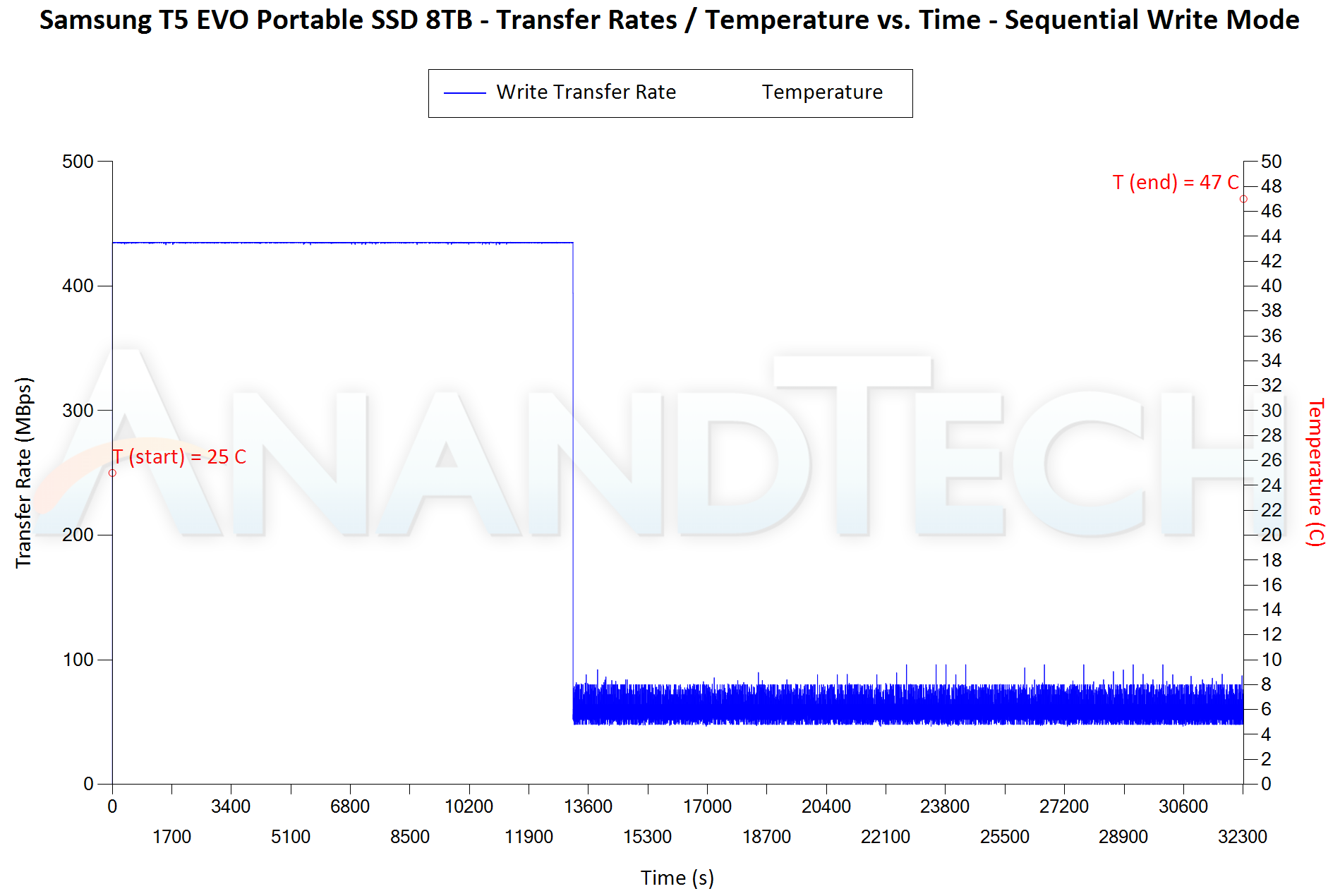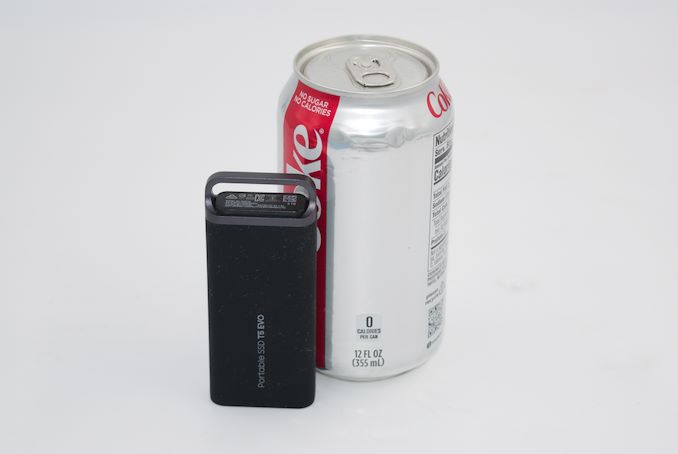Samsung T5 EVO Portable SSD Review: QLC Sets Sane Expectations, Insane Pricing
by Ganesh T S on November 14, 2023 10:00 AM EST- Posted in
- Storage
- SSDs
- Samsung
- USB 3.0
- flash
- DAS
- Type-C
- External SSDs
- Portable SSDs
Miscellaneous Aspects and Concluding Remarks
The performance of the Samsung T5 EVO in various real-world access traces as well as synthetic workloads was brought out in the preceding sections. We also looked at the performance consistency for these cases. Power users may also be interested in performance consistency under worst-case conditions, as well as drive power consumption. The latter is also important when used with battery powered devices such as notebooks and smartphones. Pricing is also an important aspect. We analyze each of these in detail below.
Worst-Case Performance Consistency
Flash-based storage devices tend to slow down in unpredictable ways when subject to a large number of small-sized random writes. Many benchmarks use that scheme to pre-condition devices prior to the actual testing in order to get a worst-case representative number. Fortunately, such workloads are uncommon for direct-attached storage devices, where workloads are largely sequential in nature. Use of SLC caching as well as firmware caps to prevent overheating may cause drop in write speeds when a flash-based DAS device is subject to sustained sequential writes.
Our Sequential Writes Performance Consistency Test configures the device as a raw physical disk (after deleting configured volumes). A fio workload is set up to write sequential data to the raw drive with a block size of 128K and iodepth of 32 to cover 90% of the drive capacity. The internal temperature is recorded at either end of the workload, while the instantaneous write data rate and cumulative total write data amount are recorded at 1-second intervals.
| Sequential Writes to 90% Capacity - Performance Consistency | |
| TOP: | BOTTOM: |
 |
|
 |
|
The T5 EVO is able to sustain maximum write speeds (around 440 MBps) for more than three hours before the direct-to-QLC writes start. In the latter state, the write speeds drop down to around 60 MBps. However, limiting the interface speed allows the controller to rapidly fold the data written earlier and free up SLC cache for the incoming data. An empty 8 TB T5 EVO allowed us to write as much as 5.2 TB of data before the direct-to-QLC segment. To be completely honest, it is difficult to find a use-case for a PSSD that involves writing of more than 5.2 TB of data in one shot.
Power Consumption
Bus-powered devices can configure themselves to operate within the power delivery constraints of the host port. While Thunderbolt ports are guaranteed to supply up to 15W for client devices, USB 2.0 ports are guaranteed to deliver only 2.5W (500mA @ 5V). In this context, it is interesting to have a fine-grained look at the power consumption profile of the various external drives. Using the ChargerLAB KM003C, the bus power consumption of the drives was tracked while processing the CrystalDiskMark workloads (separated by 5s intervals). The graphs below plot the instantaneous bus power consumption against time, while singling out the maximum and minimum power consumption numbers.
| CrystalDiskMark Workloads - Power Consumption | |
| TOP: | BOTTOM: |
 |
|
 |
|
The T5 EVO has a peak consumption of 4.61 W. The spike in power numbers between the 700s - 835s timestamps point to rapid folding in progress, allowing the SLC cache to be regained.
Final Words
The flash market is currently experiencing a supply glut, with pricing to the advantage of the consumers. This is reflected even in SSDs such as the 870 QVO. The 8TB version of the 870 QVO is available for purchase at less than $350. The inclusion of a bridge chip and the design of a smaller enclosure with additional thermal protection can be expected to add around $50 - $75 to that price. Charitably keeping this number at $100, we would have expected the 8TB T5 EVO to retail around $450. However, Samsung is currently selling the PSSD for $650. This is absurd pricing for a QLC PSSD with speeds limited to 5 Gbps, even if we grant that no other PSSD is currently being sold in the market at that capacity point.
The 2TB and 4TB variants are being sold at $190 and $350 respectively. The 2TB number is palatable, but things start becoming awry with the 4TB version. At that capacity point, PSSDs delivering much better performance with TLC flash and faster host interfaces are available for a much cheaper price. It is not clear whether the T5 EVO presents anything unique at the 2TB and 4TB capacity points to deserve that premium.
While the value proposition is clearly not in favor of the T5 EVO at the current price points, the product definitely deserves credit for creating a new category. QLC is notorious for its slow direct write speeds, an aspect that is easy to encounter in direct-attached storage workloads. By limiting the interface to 5 Gbps (USB 3.2 Gen 1) speeds, the SSD controller is able to fold written data to the QLC segment and free up the SLC cache for the incoming data simultaneously. This allows the end user / application to enjoy the benefits of a much larger SLC cache than what is actually available.
Most PSSDs in the market employ a DRAM-less platform to bring down power consumption and cost. Interestingly, the T5 EVO adopts a board with LPDDR4 RAM for the flash translation layer. This gives the T5 EVO an edge over DRAM-less SSDs (even NVMe ones) for some workloads.
On the technical and product engineering front, the T5 EVO portable SSD is a clear winner, particularly at the 8TB capacity point. The 460 MBps cap may not matter for a wide range of use-cases that is currently being served by portable hard drives. However, the insane pricing throws a spanner in the works. Hopefully, we will see Samsung take the feedback into consideration and market the T5 EVO with a slight premium over the 870 QVO.











13 Comments
View All Comments
James5mith - Tuesday, November 14, 2023 - link
"The T5 EVO is able to sustain maximum write speeds (around 440 MBps) for more than three hours"By your own graph, 180 seconds does not equate to 3 hours.
DanNeely - Saturday, November 18, 2023 - link
You're looking at the wrong graph. The t5 EVO is the top one in the pair by that comment and sustains the 440MBps speed for ~13000 seconds (3.6 hours). The bottom graph is for the comparison SSD, which sustains ~1700MBps for 3 minutes before falling down to ~900MBps.James5mith - Tuesday, November 14, 2023 - link
Sorry, I guess I was looking at the T9 graph while reading the paragraph. My mistake.GabrielFerrazTPU - Tuesday, November 14, 2023 - link
Hello my name is Gabriel Ferraz i'm the computer engineer responsible for the Techpowerup SSD Database, first of all, great job on the review, just as an insight, i'm not sure which decoder you used on that NAND Flash, but i think it's the newer 176-Layer QLC Die, i didn't see any QLC 128-Layer NAND Flash from Samsung so far. only the 512Gb / 256Gb TLV V6 and the TLC V6P (Prime) 133-Layer 512GbSlash3 - Tuesday, November 14, 2023 - link
The TPU database is a great resource; we appreciate the work that goes into it!GabrielFerrazTPU - Thursday, November 16, 2023 - link
Thank you :)I'm glad you guys liked it
ganeshts - Tuesday, November 14, 2023 - link
Gabriel, Thanks for taking the time to make this observation.I've since confirmed that this flash package is indeed 176L 7th Gen. V-NAND QLC, I have updated the article with necessary strike-throughs to reflect this fact.
GabrielFerrazTPU - Thursday, November 16, 2023 - link
You're Welcome :DBy the way, if you could do me a favor, since i'm from Brazil Samsung don't ship drives here so i can't contact them directly, do you think you could ask them more about their "V6P 133-Layer" line-up? I've recently heard about it a few days ago, but i can't find anything about it.
name99 - Tuesday, November 14, 2023 - link
"However, Samsung is currently selling the PSSD for $650... This is absurd pricing for a QLC PSSD"It's only absurd pricing if there is competition. There ISN'T.
If I want an external 8G SSD drive, what are my options?
- I can buy a QVO and an enclosure -- but most enclosures don't work with an 8TB drive. (More precisely there seems to be some confusion in the spec around 8TB, so for any random combination of 8TB drive, enclosure, PC, and OS, it's random whether it works or not)
- I can buy a VectoTech drive which is, admittedly, cheaper, but probably of weaker performance, especially for large writes.
- Or I can buy an Oyen drive of even more unknown characteristics.
That's it.
The Samsung price will come down when brands that people have actually heard of enter the market. So far, for whatever reason, that simply hasn't happened. No Crucial, no Kingston, no PNY, no Sandisk.
ganeshts - Tuesday, November 14, 2023 - link
Yes, once there is more competition from known brands in the 8TB space, the pricing will come down. But, that doesn't explain why the T9 4TB SKU is currently at $250 in both Best Buy and Amazon, while Samsung wants to charge $350 for the 4TB T5 EVO (on Amazon again).Pricing a QLC PSSD more at the same capacity as a TLC PSSD (with a faster host interface) is absurd. Samsung needs to go back to the drawing board as far as pricing is concerned.